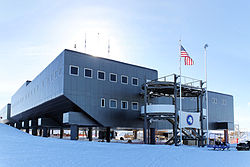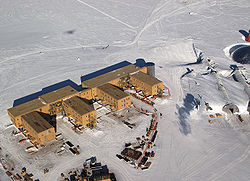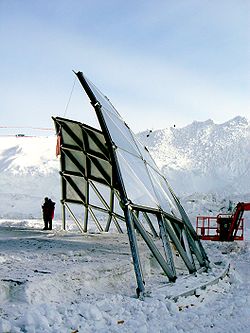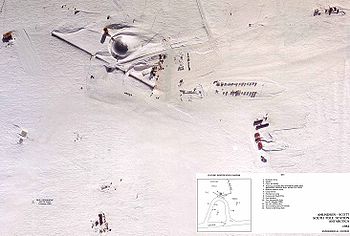- Amundsen–Scott South Pole Station
-
Coordinates: 90°00′S 139°16′W / 90°S 139.267°W
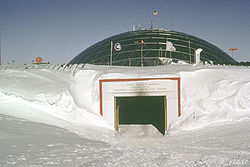 The main entrance to the former geodesic dome ramps down from the surface level. The base of the dome base was originally at the surface level of the ice cap, but the base had been slowly buried by snow and ice.
The main entrance to the former geodesic dome ramps down from the surface level. The base of the dome base was originally at the surface level of the ice cap, but the base had been slowly buried by snow and ice.
The Amundsen–Scott South Pole Station is the American scientific research station on the high plateau of Antarctica. This station is located at the southernmost place on the Earth, the Geographic South Pole, at an elevation of 2,835 meters (9301 feet) above sea level.
The original Amundsen-Scott Station was built by the United States Government during November 1956 as a part of its commitment to the scientific goals of the International Geophysical Year (I.G.Y.), an international effort lasting from January 1957 through June 1958 to study, among other things, the geophysics of the polar regions.
Before November 1956, there was no permanent human structure at the South Pole, and very little human presence in the interior of Antarctica at all. The few scientific stations in Antarctica were located on and near its seacoast. The station has been continuously occupied by people since it was built. The Amundsen-Scott Station has been rebuilt, demolished, expanded, and upgraded several times since 1956.
Since the Amundsen-Scott Station is located at the South Pole, it is at the only place on the land surface of the Earth where the sun is continuously up for six months and then continuously down for six months. (The only other such place is at the North Pole, on the sea ice in the middle of the Arctic Ocean.) Thus, during each year, this station experiences one extremely long "day" and one extremely long "night". During the six-month "day", the angle of elevation of the Sun above the horizon varies continuously. The sun rises on the September equinox, reaches its maximum angle above the horizon on the summer solstice in the Southern Hemisphere, around 20 December, and sets on the March equinox.
During the six-month "night", it gets extremely cold at the South Pole, with air temperatures sometimes dropping below −73 °C (−100 °F). This is also the time of the year when blizzards, sometimes with gale-force winds, strike the Amundsen-Scott Station. The continuous period of darkness and dry atmosphere make the station an excellent place from which to make astronomical observations.
The number of scientific researchers and members of the support staff housed at the Amundsen-Scott Station has always varied seasonally, with a peak population during the summer operational season, which lasts from October to February. In recent years the wintertime population has been around 50 people.
Contents
Description and history
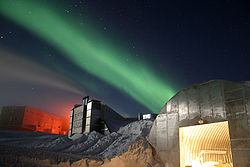 A photo of the station in the night. The new station can be seen at the far left, the electric power plant is in the center, and the old vehicle mechanic's garage in the lower right. The green light in the sky is part of the aurora australis.
A photo of the station in the night. The new station can be seen at the far left, the electric power plant is in the center, and the old vehicle mechanic's garage in the lower right. The green light in the sky is part of the aurora australis.
The Amundsen–Scott South Pole Scientific Station is the southernmost place on Earth. It is continuously inhabited. Its name honors Roald Amundsen whose Norwegian expedition reached the South Pole in December 1911, and Robert F. Scott whose British expedition of five men reached the South Pole about one month later (in January 1912) in a race to become the first man ever to reach the south pole. All of Scott's expedition perished during the journey back towards the coast, while all of Amundsen's expedition returned safely to their base on the seacoast of the continent.
The original Amundsen–Scott Scientific Station was constructed during November of 1956 to carry out part of the International Geophysical Year (I.G.Y.) of scientific observations during 1957 through 1958, and the station has been continuously occupied since then. This station currently lies within 100 meters (330 ft) of the Geographic South Pole. Because this station is located on a moving glacier, this station is currently being carried towards the South Pole at a rate of about 10 meters (or yards) per year. Although the United States Government has continuously maintained an installation at the South Pole since 1957, the central berthing, galley, and communications units have been constructed and relocated several times. Each of the installations containing these central units has been named the Amundsen–Scott South Pole Station.
Snow accumulation is about 60–80 millimeters (water equivalent) per year (3 in/yr). The station stands at an elevation of 2,835 meters (9,301 ft) on the interior of Antarctica's nearly featureless ice sheet, which is about 2,850 meters (9,350 ft) thick at that location. The recorded temperature has varied between −13.6 °C (7.5 °F) and −82.8 °C (−117 °F), with an annual mean of −49 °C (−56 °F); monthly mean temperatures vary from −28 °C (−18 °F) in December to −60 °C (−76 °F) in July. The average wind speed is 5.5 m/s (12 mph); the peak gust recorded was 25 m/s (55 mph).[1]
Original station (1957–1975)
The original South Pole station, now referred to as "Old Pole", was constructed by an 18-man United States Navy crew during 1956–1957. The crew landed on site in October 1956 and was the first group to winter-over at the South Pole, during 1957. Since the winter conditions at the South Pole had never been measured, the station was built partially underground in order to protect it from the worst imaginable weather. The low temperature recorded during 1957 was −74 °C (−102 °F). These temperatures, combined with low humidity and low air pressure, are survivable only with specialized equipment.
On 3 January 1958 Sir Edmund Hillary's New Zealand part of the Commonwealth Trans-Antarctic Expedition reached the station over land from Scott Base, followed shortly by Sir Vivian Fuchs' British scientific component.
As with all structures at the South Pole, the original station caused wind-blown snow to build up in the surrounding area. This snow accumulation resulted in the structure being further buried by about four feet of snow per year.
The station was abandoned in 1975 and became deeply buried, with the pressure causing the mostly wooden roof to cave in. The station was demolished in December of 2010, after an equipment operator fell through the structure doing snow stability testing for the NSF.[2] The area was being vetted for use as a campground for NGO guests.
Dome (1975–2003)
The station was relocated and rebuilt in 1975 as a geodesic dome 50 meters (164 ft) wide and 16 meters (52 ft) high, with 14×24 m (46x79 ft) steel archways, modular buildings, fuel bladders, and equipment. Detached buildings within the dome housed instruments for monitoring the upper and lower atmosphere and for numerous and complex projects in astronomy and astrophysics. The station also included the skylab, a box-shaped tower slightly taller than the dome. Skylab was connected to the Dome by a tunnel. The Skylab housed atmospheric sensor equipment and later a music room.
During the 1970–1974 summers, the dome construction workers were housed in Korean War tents, or "jamesways". These tents consist of a wooden frame with a raised platform covered by canvas. A double-doored exit is at each end. Although the tents are heated, the heat output is not sufficient to keep them at room temperature during the winter. After several jamesways burned down during the 1976–1977 summer, the construction camp was abandoned and later removed.
However, starting in the 1981–1982 summer, extra seasonal personnel have been housed in a group of jamesways known as "summer camp". Initially consisting of only two jamesways, summer camp at its peak consisted of 11 berthing tents housing about 10 people each, two recreational tents and bathroom and gym facilities. In addition, a number of science and berthing structures, such as the hypertats and elevated dorm, were added in the 1990s, particularly for astronomy and astrophysics.
During the period in which the dome served as the main station, many changes to US South Pole operation took place. From the 1990s on, astrophysical research conducted at the South Pole took advantage of its favorable atmospheric conditions and began to produce important scientific results. Such experiments include the Python, Viper, and DASI telescopes, as well as the 10 m (394 in) South Pole Telescope. The AMANDA / IceCube experiment makes use of the two-mile (3 km)-thick ice sheet to detect neutrinos which have passed through the earth. An observatory building, the Martin A. Pomerantz Observatory (MAPO), was dedicated in 1995. The importance of these projects changed the priorities in station operation, increasing the status of scientific cargo and personnel.
The 1998–1999 summer season was the last year that the US Navy operated the five to six LC-130 Hercules service fleet. Beginning in 1999–2000, the New York Air National Guard 109th Airlift Wing took responsibility for the daily cargo and passenger ("PAX") flights between McMurdo Station and the South Pole during the summer.
Elevated station (2003–present)
In 1992, the design of a new station began for a 7,400 m2 (80,000 sq ft), 2-story building that cost $150 million.[3] Construction began in 1999, adjacent to the Dome. The facility was officially dedicated on Jan. 12, 2008 with a ceremony that included the de-commissioning of the old Dome station.[4] The ceremony was attended by a number of dignitaries flown in specifically for the day, including National Science Foundation Director Arden Bement, scientist Susan Solomon and other government officials.
The new station included a modular design, to accommodate an increasing station population, and an adjustable elevation, in order to prevent the station from being buried in snow. In a location where about 20 centimetres (8 in) of snow accumulates every year without ever thawing,[5][6] the building's rounded corners and edges help reduce snow drifts. The building faces into the wind with a sloping lower portion of wall. The angled wall increases the wind speed as it passes above, causing the snow to be scoured away, keeping the building from being quickly buried. Wind tunnel tests show that scouring will continue to occur until the snow level reaches the second floor.
Because snow gradually settles over time under its own weight, the foundations of the building were designed to accommodate substantial differential settling over any one wing in any one line or any one column. If differential settling continues, the supported structure will need to be jacked up and re-leveled. The facility was designed with the primary support columns outboard of the exterior walls so that the entire building can be jacked up a full story. During this process, a new section of column will be added over the existing columns then the jacks pull the building up to the higher elevation.
Operation
During the summer the station population is typically over 200. Most personnel leave by the middle of February, leaving a few dozen (47 in 2010) "winter-overs", mostly support staff plus a few scientists, who keep the station functional through the months of Antarctic night. The winter personnel are isolated between mid-February and late October. Wintering-over offers notorious dangers and stresses, as the station population is almost totally isolated. The station is completely self-sufficient during the winter, and powered by three generators running on JP-8 jet fuel. An annual tradition is a double feature viewing of The Thing and The Shining after the last flight has left for the winter.[7]
Research at the station includes glaciology, geophysics, meteorology, upper atmosphere physics, astronomy, astrophysics, and biomedical studies. In recent years, most of the summer scientists have worked for the IceCube Neutrino Observatory or for low-frequency astronomy experiments such as the South Pole Telescope and BICEP2. The low temperature and low moisture content of the polar air, combined with the altitude of over 2743 m (9,000 ft), causes the air to be far more transparent on some frequencies than is typical elsewhere, and the months of darkness permit sensitive equipment to run constantly.There is a small greenhouse at the station. The variety of vegetables and herbs in the greenhouse, which range from fresh eggplant to jalapeños, are all produced hydroponically, using only water and nutrients and no soil. The greenhouse is the only source of fresh fruit and vegetables during the winter.
Transportation
Main article: Jack F. Paulus SkiwayThe station has a runway for aircraft (ICAO: NZSP), 3658 m / 12000 ft long. Between October and February, there are several flights per day of ski-equipped LC-130 Hercules aircraft from McMurdo to supply the station. Resupply missions are collectively termed Operation Deep Freeze.
There is a snow road over the ice sheet from McMurdo, the McMurdo-South Pole highway.
Communication
- For more detail, see Telecommunications in Antarctica
Data access to the station is provided by access via NASA's TDRS-F1, Marisat, LES 9, GOES & Iridium satellite constellation. For the 2007-2008 season, the TDRS relay (named South Pole TDRSS Relay or SPTR) was upgraded to support a data return rate of 50 Mbit/s, which comprises over 90% of the data return capability.[8][9]
Climate
The peak season of summer lasts October to February.
Climate data for the South Pole Month Jan Feb Mar Apr May Jun Jul Aug Sep Oct Nov Dec Year Record high °C (°F) −14
(7)−20
(−4)−26
(−15)−27
(−17)−30
(−22)−31
(−24)−33
(−27)−32
(−26)−29
(−20)−29
(−20)−18
(0)−13
(9)−13
(9)Average high °C (°F) −25.9
(−14.6)−38.1
(−36.6)−50.3
(−58.5)−54.2
(−65.6)−53.9
(−65.0)−54.4
(−65.9)−55.9
(−68.6)−55.6
(−68.1)−55.1
(−67.2)−48.4
(−55.1)−36.9
(−34.4)−26.5
(−15.7)−46.3 Average low °C (°F) −29.4
(−20.9)−42.7
(−44.9)−57
(−70.6)−61.2
(−78.2)−61.7
(−79.1)−61.2
(−78.2)−62.8
(−81.0)−62.5
(−80.5)−62.4
(−80.3)−53.8
(−64.8)−40.4
(−40.7)−29.3
(−20.7)−52 Record low °C (°F) −41
(−42)−57
(−71)−71
(−96)−75
(−103)−78
(−108)−82.8
(−117.0)−80
(−112)−77
(−107)−79
(−110)−71
(−96)−55
(−67)−38
(−36)−82.8
(−117.0)Sunshine hours 558 480 217 0 0 0 0 0 60 434 600 589 2,938 Source no. 1: Weatherbase[10] Source no. 2: Cool Antarctica[11] Media and events
In 1991, Michael Palin visited the base on the 8th and final episode of his BBC Television Documentary, Pole to Pole.
On January 10, 1995, NASA, PBS, and NSF collaborated for the first live TV broadcast from the South Pole, titled Spaceship South Pole.[12] During this interactive broadcast, students from several schools in the United States asked the scientists at the station questions about their work and conditions at the pole.[13]
In 1999, the winter-over physician, Dr. Jerri Nielsen, found that she had breast cancer. She had to rely on self-administered chemotherapy using supplies from a daring July cargo drop, then was picked up in an equally dangerous mid-October landing.
On 11 May 2000 astrophysicist Dr. Rodney Marks became ill while walking between the remote observatory and the base. He became increasingly sick over 36 hours, three times returning increasingly distressed to the station's doctor. Advice was sought by satellite, but Dr Marks died on 12 May 2000 with his condition undiagnosed.[14][15] The National Science Foundation issued a statement that Rodney Marks had "apparently died of natural causes, but the specific cause of death ha[d] yet to be determined".[16] The exact cause of Marks' death could not be determined until his body was removed from Amundsen-Scott Station and flown off Antarctica for an autopsy.[17] Marks' death was due to methanol poisoning, and the case received media attention as the "first South Pole murder",[18] although there is no evidence that Marks died as the result of the act of another person.[19]
In January 2007 the station was visited by a group of high-level Russian officials, including FSB chiefs Nikolay Patrushev and Vladimir Pronichev. The expedition, led by polar explorer Artur Chilingarov, started from Chile on two Mi-8 helicopters and landed at the South Pole.[20][21]
On September 6, 2007, The National Geographic Channel's TV show Man Made aired an episode on the construction of their new facility.[22]
On the November 9th, 2007 edition of NBC's Today (NBC program), Today show co-anchor Ann Curry made a satellite telephone call which was broadcast live from the South Pole.[23]
In 1999, CBS News correspondent Jerry Bowen reported on camera in a talkback with anchors from the Saturday edition of CBS This Morning.
On Christmas 2007, two employees at the base got into a drunken fight and had to be evacuated.[24]
During the 2011 winterover season, station manager Renee-Nicole Douceur experienced a stroke on August 27, resulting in loss of vision and cognitive function. Because the Amundsen-Scott base lacks diagnostic medical equipment such as an MRI or CT scan machine, station doctors were unable to fully evaluate the damage done by the stroke or the chance of recurrence. Physicians on site recommended a medevac flight as soon as possible for Douceur, but offsite doctors hired by Raytheon Polar Services (the company contracted to run the base) and the National Science Foundation disagreed with the severity of the situation. The National Science Foundation, which is the final authority on all flights and assumes all financial responsibility for the flights, denied the request for medevac saying the weather was still too hazardous[25]. Plans were made to evacuate Douceur on the first flight available. Douceur and her niece, believing Douceur's condition to be grave and believing an earlier medevac flight possible, contacted Senator Jeanne Shaheen for assistance; as the NSF continued to state Douceur's condition did not qualify for a medevac attempt and conditions at the base would not permit an earlier flight, Douceur and her supporters brought the situation to media attention.[26][27]
Douceur was evacuated on October 17 on a cargo flight that had cargo intended for the other residents of the base removed to make space for her, a doctor and an escort. This was the first flight available when the weather window opened up on October 16. This first flight is usually solely for supply and refueling of the station, and does not customarily accept passengers, as the plane's cabin is unpressurized.[28] [29] The evacuation was successful, and Douceur arrived in Christchurch, New Zealand, at 4:55 a.m. ET.[30]
In popular culture
The station has featured prominently in several science fiction television series, including The X-Files movie Fight the Future.
A South Pole station called Snowcap Base was the site of the first Cybermen invasion of earth in the 1966 Doctor Who serial The Tenth Planet.
Science fiction author Kim Stanley Robinson's book Antarctica features a fictionalized account of the culture at Amundsen–Scott and McMurdo, set in the near future.
In the fourth season episode of House MD entitled "Frozen", Gregory House is tasked to help a female patient by videoconference who was located at 'an Antarctic outpost'; this was likely modeled on the Jerri Nielsen incident mentioned above.
The BBC program On Thin Ice covered the participation of two-time British Olympic gold medalist James Cracknell, television host Ben Fogle and Dr. Ed Coates in the first organised race to the South Pole since Amundsen beat Scott. The final episode of the five part series showed the three arriving at the South Pole, with the Amundsen–Scott Station in the background. The three finished second, twenty hours behind a two-man team from Norway.
The 2009 film Whiteout is mainly set at the Amundsen–Scott base, although the building layouts are completely different.
The 1938 science fiction story Who Goes There? was set at the South Pole and has been made into a film three times: by Howard Hawks in 1951, by John Carpenter in 1982, and by Matthijs van Heijningen Jr. in 2011.
Time zone
The South Pole sees the sun rise and set only once a year, technically on the September equinox and the March equinox, respectively, but atmospheric refraction means that the sun is above the horizon for some four days longer at each equinox. The place has no solar time; there is no daily maximum or minimum solar height above the horizon. The station uses New Zealand time (UTC+12, UTC+13 during daylight saving time) since all flights to McMurdo station depart from Christchurch and therefore all official travel from the pole goes through New Zealand.
The tz database zone identifier is Antarctica/South_Pole.
See also
- Polheim, Amundsen's name for the first South Pole camp.
- Scott Base
- List of research stations in Antarctica
References
- ^ "National Science Foundation South Pole Station". http://www.nsf.gov/od/opp/support/southp.jsp. Retrieved 2010-09-11.
- ^ "South Pole's first building blown up after 53 years". OurAmazingPlanet.com. 2011-03-31. http://www.mnn.com/earth-matters/wilderness-resources/stories/south-poles-first-building-blown-up-after-53-years.
- ^ "nsf.gov OPP MREFC South Pole Station Modernization - FY08 budget request" (PDF). http://www.nsf.gov/od/opp/budget/08_budget/fy08_southpole.pdf. Retrieved 2009-11-08.
- ^ "A New Era". The Antarctic Sun. 2009-05-01. http://antarcticsun.usap.gov/science/contenthandler.cfm?id=1315. Retrieved 2009-05-01.
- ^ Modern Marvels episode, "Sub-Zero Tech".
- ^ Initial environmental evaluation – development of blue-ice and compacted-snow runways, National Science Foundation Office of Polar Programs, April 9, 1993
- ^ "The Antarctic Sun". antarcticsun.com. http://antarcticsun.usap.gov/aroundTheContinent/contentHandler.cfm?id=1602. Retrieved August 14, 2011.
- ^ "South Pole-News". Southpolestation.com. http://www.southpolestation.com/news/news.html. Retrieved 2009-11-08.
- ^ "South Pole TDRSS Relay (SPTR)". Msp.gsfc.nasa.gov. 2000-09-01. http://msp.gsfc.nasa.gov/SPTR/. Retrieved 2009-11-08.
- ^ "South Pole, Antarctica". WeatherBase. http://www.weatherbase.com/weather/weather.php3?s=90098&refer=&units=metric. Retrieved 2009-10-07.
- ^ "Antarctica Climate data and graphs". http://www.coolantarctica.com/Antarctica%20fact%20file/antarctica%20environment/climate_graph/vostok_south_pole_mcmurdo.htm. Retrieved 2010-04-10.
- ^ "Live From Antarctica". Passport to Knowledge. http://passporttoknowledge.com/antarctica/interact/updates/lfa/four.html. Retrieved 2010-10-04.
- ^ Greg Falxa. "Tech Crew at the South Pole Interactive TV Broadcast". Falxa.net. http://www.falxa.net/spole.htm. Retrieved 2009-11-08.
- ^ Harvard-Smithsonian Center for Astrophysics. "In Memoriam". The CfA Almanac Vol. XIII No. 2, July 2000. Retrieved on December 19, 2006.
- ^ Amundsen-Scott South Pole Station. Memorial. Retrieved on December 19, 2006.
- ^ "Antarctic Researcher Dies". National Science Foundation Office of Legislative and Public Affairs, Press release May 12, 2000. Retrieved December 19, 2006.
- ^ "Australian scientist dies during Pole winter". The Antarctic Sun October 22, 2000. Retrieved on December 19, 2006.
- ^ Chapman, Paul (14 December 2006). "New Zealand Probes What May Be First South Pole Murder". The Daily Telegraph. http://www.telegraph.co.uk/news/main.jhtml?xml=/news/2006/12/14/wpole14.xml. Retrieved 2006-12-19.
- ^ "Death of Australian astrophysicist an Antarctic whodunnit". Deutsche Presse-Agentur. 14 December 2006. http://news.monstersandcritics.com/asiapacific/news/printer_1233162.php. Retrieved 2006-12-19.
- ^ Patrushev lands at South Pole during Antarctic expedition[dead link]
- ^ "Two Russian helicopters land at the South Pole". Timesrussia.com. http://www.timesrussia.com/two-russian-helicopters-landed-at-south-pole-for-the-first-time. Retrieved 2009-11-08.
- ^ National Geographic Channel's South Pole Project[dead link]
- ^ 10:36 a.m. ET (2007-11-09). "Ann Curry's live broadcast from the South Pole". MSNBC. http://www.msnbc.msn.com/id/21706630/. Retrieved 2009-11-08.
- ^ McMahon, Barbara (2007-12-27). "Antarctic base staff evacuated after Christmas brawl". London: Guardian. http://www.guardian.co.uk/international/story/0,,2232454,00.html. Retrieved 2009-11-08.
- ^ {http://www.weather.com/weather/videos/news-41/top-stories-169/pilot-describes-antarctica-wx-challenges-22222}
- ^ "Worker at South Pole Station Pushes for a Rescue After a Stroke". New York Times. 2011-10-07. http://www.nytimes.com/2011/10/08/science/08southpole.html?_r=1. Retrieved 2011-10-14.
- ^ "Evacuation is denied for South Pole stroke victim". MSNBC. http://www.msnbc.msn.com/id/44820005/ns/technology_and_science-science/. Retrieved 2011-10-14.
- ^ "Raytheon worker stuck in South Pole is coming home". Boston Herald. http://news.bostonherald.com/business/technology/general/view/2011_1012raytheon_worker_stuck_in_south_pole_is_coming_home/srvc=home&position=recent. Retrieved 2011-10-14.
- ^ "South Pole: Stroke Victim Waits for Plane Flight". ABC News. http://abcnews.go.com/Technology/south-pole-stroke-victim-renee-nicole-douceur-waits/story?id=14711852. Retrieved 2011-10-14.
- ^ [1]
External links
- Live webcam image from Usap
- Amundsen-Scott Station Noaa webcam
- National Science Foundation: Amundsen–Scott South Pole Station
- Unofficial website on the Station: news, gallery, history
- COMNAP Antarctic Facilities
- COMNAP Antarctic Facilities Map
- Airport information for NZSP at World Aero Data. Data current as of October 2006.
- Current weather for NZSP at NOAA/NWS
Antarctica Main articles - Antarctic
- History
- Geography
- Climate
- Expeditions
- Research stations
- Field camps
- Territorial claims
- Antarctic Treaty System
- Telecommunications
- Demographics
- Economy
- Tourism
- Transport
- Military activity in the Antarctic
Geographic regions - Antarctic Peninsula
- East Antarctica
- West Antarctica
- Extreme points of the Antarctic
- List of Antarctic and subantarctic islands
- Antarctica ecozone
Waterways Famous explorers Research stations of Antarctica Year-round Argentina- Belgrano II
- Esperanza
- Jubany
- Marambio
- Orcadas
- San Martín
Europe- Princess Elisabeth (Belgium)
- Concordia / Dumont d'Urville (France)
- Concordia / Mario Zucchelli (Italy)
- Neumayer III (Germany)
- Troll (Norway)
- Arctowski (Poland)
- Halley / Rothera (UK)
- Vernadsky (Ukraine)
RussiaOthers- Comandante Ferraz (Brazil)
- Great Wall / Zhongshan (PR China)
- Maitri (India)
- Dome Fuji / Showa (Japan)
- King Sejong (South Korea)
- Scott (New Zealand)
- SANAE IV (South Africa)
- Artigas (Uruguay)
Summer - Almirante Brown / Cámara / Decepción / Matienzo / Petrel (Argentina)
- St. Kliment Ohridski (Bulgaria)
- Carvajal / González Videla / Risopatrón (Chile)
- Kunlun (China)
- Mendel (Czech Republic)
- Maldonado (Ecuador)
- Aboa (Finland)
- Kohnen (Germany)
- Zucchelli (Italy)
- Dome Fuji (Japan)
- Tor (Norway)
- Jinnah (Pakistan)
- Machu Picchu (Peru)
- Law-Racoviţă (Romania)
- Gabriel de Castilla / Juan Carlos I (Spain)
- Svea / Wasa (Sweden)
- Signy (UK)
- Byrd (United States)
- Elichiribehety (Uruguay)
Closed - Dakshin Gangotri (India)
- Asuka / Mizuho (Japan)
- Hallett / Vanda (New Zealand)
- Komsomolskaya / Leningradskaya / Molodyozhnaya / Russkaya (Soviet Union)
- Ellsworth (USA / Argentina)
- World Park Base (Greenpeace)
Categories:- Outposts of Antarctica
- United States Antarctic Program
- Protected areas of Antarctica
Wikimedia Foundation. 2010.

